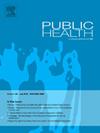意大利西北部一个队列的出生体重与成年期死亡率之间的关系
IF 3.2
3区 医学
Q1 PUBLIC, ENVIRONMENTAL & OCCUPATIONAL HEALTH
引用次数: 0
摘要
每年,全世界约有15%的新生儿体重不足。研究发现,低出生体重与各种健康状况或所有特定原因(如心血管疾病)的死亡率之间存在关联。此外,高出生体重是患上或死于某些疾病(如癌症)的风险因素。本研究旨在通过都灵纵向研究(TLS)调查出生体重与不同原因导致的成人死亡率之间的关系,该研究包含了出生于20世纪20年代并于1971年至2013年随访的一组受试者的信息。研究设计数据来自健康管理队列TLS。方法在意大利都灵的Sant’anna医院出生的约3500名受试者被纳入研究。研究了不同的结果:全因死亡率、创伤、癌症、心血管、呼吸、神经系统和消化系统疾病导致的死亡。关于暴露,评估出生体重为2500g、2800g和≥4000g。进行生存和竞争风险分析,拟合Cox、病因特异性和亚分布比例风险模型。结果排除后,共纳入受试者2992例。低出生体重是各种原因导致的死亡和心血管疾病的一个危险因素。按性别分层,它与女性心血管疾病和男性神经系统疾病的死亡率有关。结论本研究发现,低出生体重是全因死亡和某些特定原因(如心血管和神经系统疾病)死亡的危险因素。这些发现支持有必要实施政策,以减少出生体重异常的受试者数量。本文章由计算机程序翻译,如有差异,请以英文原文为准。
Association between birth weight and mortality in adulthood in a cohort from North-West Italy
Objective
Yearly, around 15 % of newborns worldwide are underweight. Studies found associations between low birth weight and various health conditions or mortality for all and specific causes, such as cardiovascular. Moreover, high birth weight was a risk factor for developing or dying from certain conditions, such as cancer.
This study aims to investigate the association between birth weight and adult mortality from different causes through the Turin Longitudinal Study (TLS), containing information on a cohort of subjects born in the 1920s and followed from 1971 to 2013.
Study design
Data were obtained from the TLS, a health-administrative cohort.
Methods
Around 3500 subjects born at the Sant’Anna hospital (Turin, Italy) were enrolled. Different outcomes were investigated: all-cause mortality, and death from traumatisms, cancer, cardiovascular, respiratory, nervous system, and digestive apparatus diseases. Regarding exposures, birth weights <2500g, <2800g, and ≥4000g were assessed. Survival and Competing Risk analyses were performed, fitting Cox, Cause-Specific, and Subdistribution Proportional Hazards models.
Results
After exclusions, 2992 individuals were considered. Low birth weight was a risk factor for death from all causes and cardiovascular diseases. Stratifying by sex, it was associated with mortality from cardiovascular conditions among females and from nervous system diseases in males.
Conclusions
In this research, it emerged that low birth weight is a risk factor for death from all-cause mortality and some specific causes, such as cardiovascular and nervous system diseases. These findings support the need to implement policies to reduce the number of subjects born with non-normal weight.
求助全文
通过发布文献求助,成功后即可免费获取论文全文。
去求助
来源期刊

Public Health
医学-公共卫生、环境卫生与职业卫生
CiteScore
7.60
自引率
0.00%
发文量
280
审稿时长
37 days
期刊介绍:
Public Health is an international, multidisciplinary peer-reviewed journal. It publishes original papers, reviews and short reports on all aspects of the science, philosophy, and practice of public health.
 求助内容:
求助内容: 应助结果提醒方式:
应助结果提醒方式:


